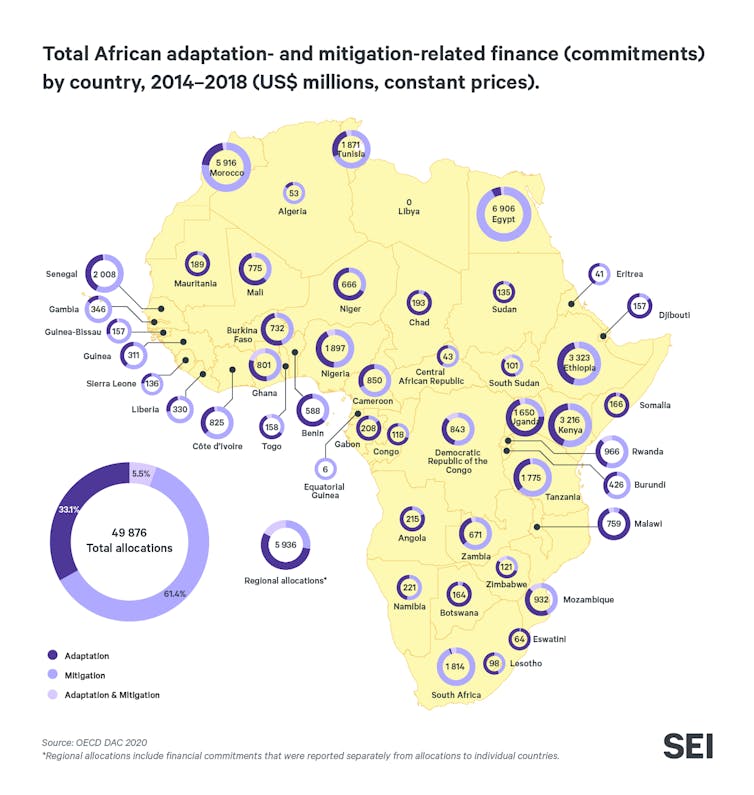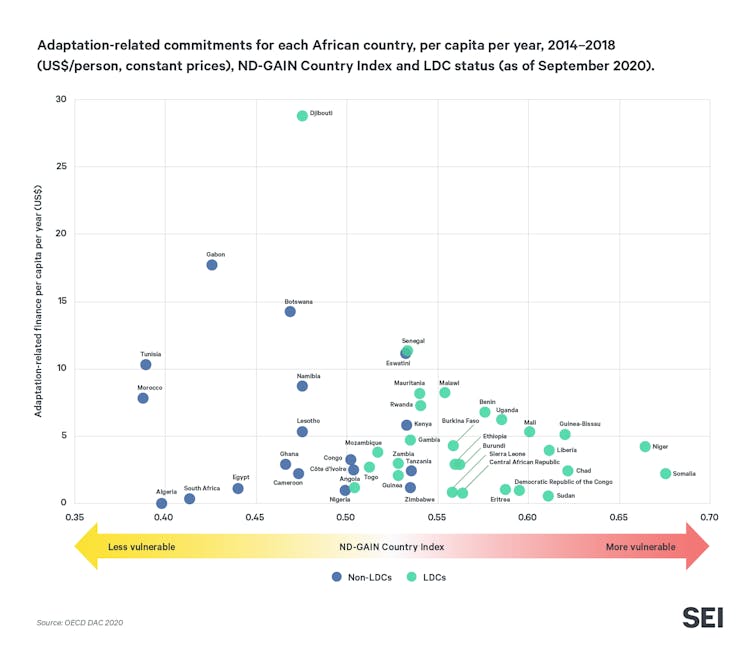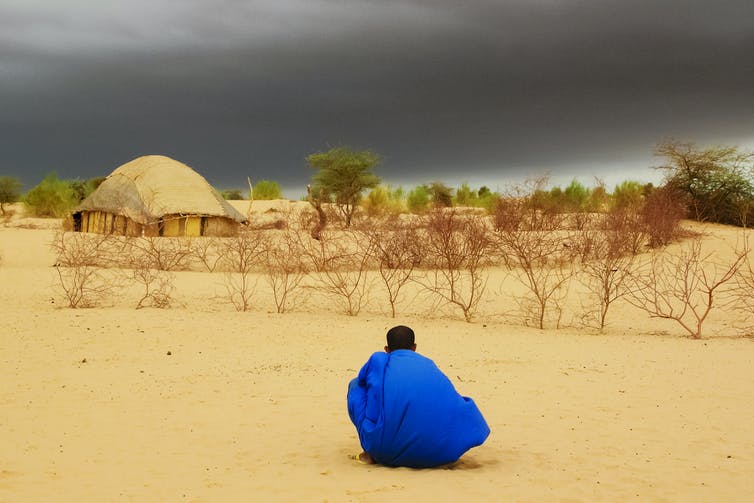Key Points
- The world’s poorest countries are expected to be hit hardest by climate change extremes such as droughts, floods and cyclones.
- Poorer populations in sub-Saharan Africa are at highest risk of malnutrition.
- Without financial support, climate change is projected to push tens of millions more Africans into extreme poverty by 2030.
Georgia Savvidou, Chalmers University of Technology and Christopher Trisos, University of Cape Town
Back in 2009, the world’s wealthier nations pledged to mobilise US$100 billion a year by 2020 to help developing countries cope with climate change. The funding would be used to adapt to the impacts of climate change and reduce or prevent emissions.
The world’s poorest countries are expected to be hit hardest by climate change extremes such as droughts, floods and cyclones. And African countries are among the most vulnerable to those impacts on food security, health, economies and ecosystems. For example, crop yield loss projections are larger for tropical regions of Africa. And poorer populations in sub-Saharan Africa are at highest risk of malnutrition.
At the same time, Africa’s contributions to greenhouse gas emissions causing global warming are among the lowest globally.
Without financial support, climate change is projected to push tens of millions more Africans into extreme poverty by 2030.
Our new research, based on data from the Organisation for Economic Co-operation and Development (OECD), tracked funding for adaptation to African nations from 2014 to 2018. The funding came from governments in wealthy countries and development banks. The work is important as there has been no extensive mapping of climate finance to Africa to date.
We identified five ways in which finance for adaptation to climate change in Africa falls short. These are: quantity; variation among countries; neglect of some sectors; difficulty spending funds and debt.
Adaptation finance doesn’t match the needs
Roughly US$5 per year, per person. That’s what adaptation funding to each African amounted to between 2014 and 2018, at a grand total of less than US$5.5 billion per year.
African governments estimate that they need at least US$7.4 billion per year by 2020. They also expect that they will need much more as the world gets ever hotter – reaching tens of billions of dollars per year by 2050.
It’s clear that the world’s poorest countries will be hit hardest by climate hazards and extreme weather events. The World Bank estimates that sub-Saharan Africa will face the highest adaptation costs per unit of gross domestic product (GDP). This is because of lower GDPs and higher costs of adaptation for water resources, due to changes in precipitation patterns.
But we found that funding from 2014 to 2018 targeting adaptation (US$16.5 billion) was only about half of the funding aimed at reducing emissions (mitigation), which was US$30.6 billion. While finance for mitigation is important because it addresses the root cause of climate change, for African countries that already face severe climate impacts, increased funding for adaptation is urgent.

Some countries are more vulnerable than others
Funders haven’t strategically targeted adaptation finance to the most vulnerable African countries. Per capita funding levels are almost the same for least-developed and more developed countries.

Generally, least-developed countries are also more vulnerable to the impacts of climate change. Niger, Somalia, Chad, Sudan and Liberia rank among the most vulnerable countries in the world. Yet they receive less than US$5 per person per year to adapt to weather extremes.
Not all sectors in need receive adaptation finance
Only two sectors, agriculture and water supply & sanitation, received half of the adaptation-related funding. To some extent this aligns with the expected vulnerability and exposure of these sectors to climate impacts. Also, African governments prioritise these sectors in their climate plans.
But money also needs to go to sectors such as education, health and biodiversity and have gender equality as a main objective. Healthy, educated people are more resilient to climate shocks, both socially and economically. And healthy natural ecosystems reduce direct and indirect climate risks. Funded programmes that empower women and take into account the unique needs and priorities of both women and men are found to be more effective.
Unspent adaptation finance
We need to ensure that funding is doing what it set out to do once it reaches poor countries, instead of having negative impacts as some literature suggests. But our research shows that most of it doesn’t even reach countries. Only 46% of adaptation finance committed to Africa was actually disbursed.
By contrast, finance for reducing greenhouse gas emissions was being spent at a rate of 56%. And 96% of overall development finance that funders committed to Africa over the same period was actually spent.
This suggests some major barriers to spending on climate projects, particularly for adaptation projects. Literature that has looked at this problem in more detail suggests that administrations in less developed countries are often not set up to properly plan procurement. They often have to comply with strict funding conditions and guidelines, find counterpart funding within the time that’s agreed, or comply with rigid rules of multilateral climate funds.
Adaptation finance leads to more debt
More adaptation related finance was provided as loans (57%) than as grants (42%). Poor and often highly indebted countries are largely expected to pay back money for adapting to climate hazards they’ve done very little to cause.
Aside from climate justice, on a practical level, grant-based finance has higher disbursement rates than loans. Adaptation finance could make a bigger difference if more of it was provided in the form of grants.
Looking ahead
Climate finance is probably the biggest key – or obstacle – to success at the upcoming UN climate conference COP26 in Glasgow in 2021. The OECD has found that the promise of $100 billion per year for developing nations by 2020 has fallen short by $20 billion.
But our research suggests that climate finance is about more than just one aggregate number. The money must match the needs, in terms of amount and purpose. It must go to all the sectors where it’s needed to put people in a better position to deal with the impacts of climate change.
Funders and recipients must identify and solve the problems preventing money from actually making a difference on the ground. And funders must reconsider the quality of the finance, especially whether it’s provided in a just and effective form.![]()
Georgia Savvidou, PhD candidate , Chalmers University of Technology and Christopher Trisos, Senior Research Fellow, University of Cape Town
This article is republished from The Conversation under a Creative Commons license. Read the original article.

